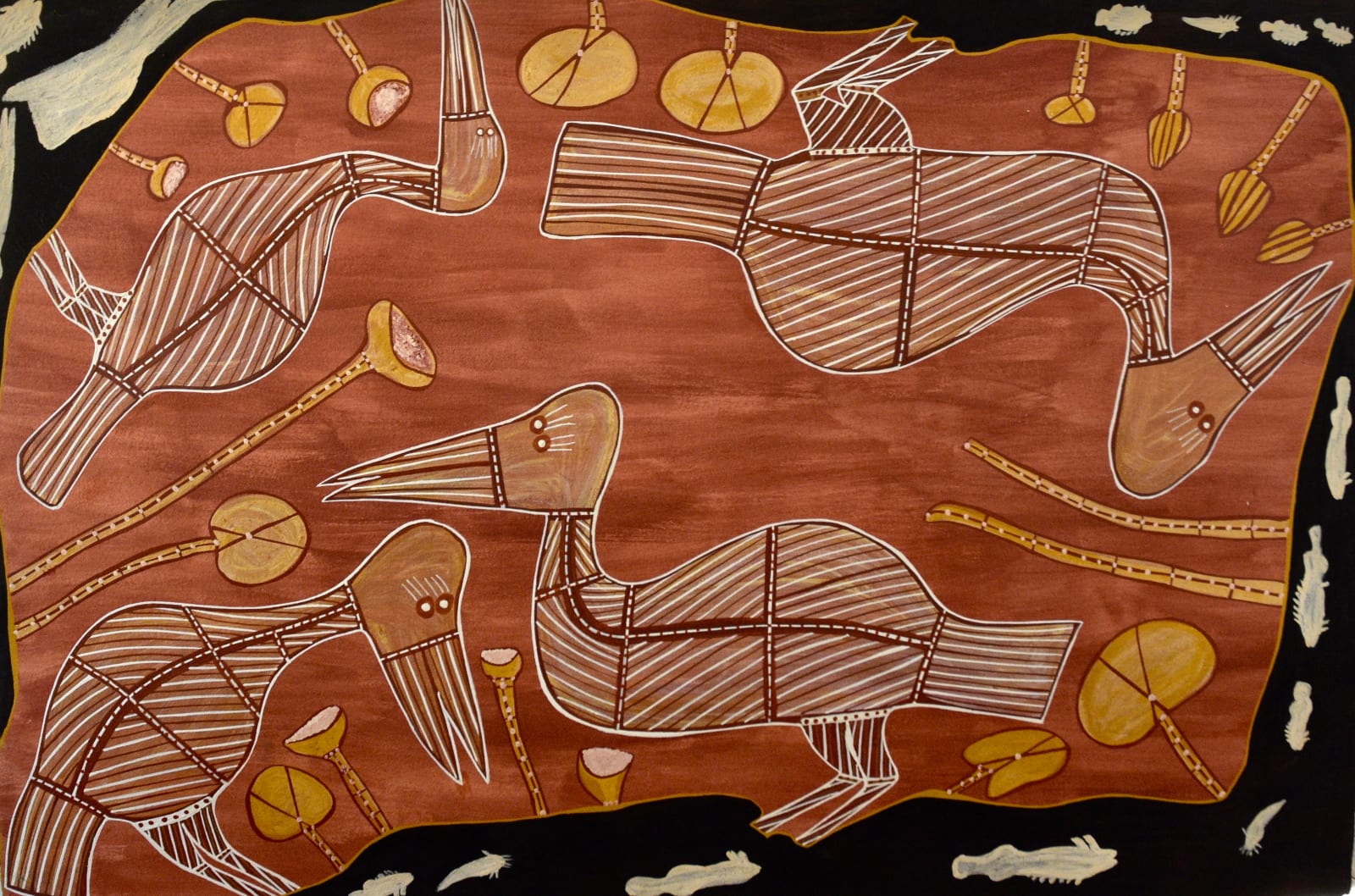BININJ DJANG (MEN DREAMING): JOE GUYMALA, SHAUN NAMARMYILK, GRAHAM BADARI, GLEN NAMUNDJA
Past exhibition
Joe Guymala Australian, Kunwinjku, b. 1969
Kulabbarl (Billabong), 2021
acrylic on arches paper
154 x 102 cm
587-21
Three Jabiru and an Egret in a Kulabbarl. Joe has painted three birds hunting at the edge of a billabong. You can often see these magnificent birds standing motionless at...
Three Jabiru and an Egret in a Kulabbarl. Joe has painted three birds hunting at the edge of a billabong. You can often see these magnificent birds standing motionless at the border of the water, waiting for fish to swim by. Joe has painted both beneath and on top of the water, giving an almost x-ray insight into the different activities happening around the billabong. The birds, and the lily pads look content, amicably enjoying a sunny afternoon's fishing. Kulabbarl is what Bininj (Aboriginal people) call a billabong, where the flow of a river is blocked and builds up in the rain. Lots of fish are concentrated there, especially when the
water starts to recede in the dry season. In small billabongs, we catch things like burd (freshwater bream), marrngunj (small eel-tailed catfish) wakih (freshwater shrimp), kedjebe (file snakes) and ngalmangiyi (long- necked turtle). And in big billabongs, we go and get fish like namarnkol (barramundi), kuluybirr (saratoga) and manmakkawarri (catfish). Sometimes we see kinga (saltwater crocodiles) or kumoken (freshwater crocodiles). There are manimunak (magpie geese), djilikuybi (whistling ducks) and lots of other birds which we eat at billabongs.
Manbu kulabbarl ngarriyime bu kudjewk mandjewk nawern kadjakdung wanjh kabore kore mankabo. Wanjh bu kabongurdme kabodadjme wanjh kamarnbun manlabbarl. Kumekke djenj kadjaldi kore kulabbarl. Kulabbarl karri djenj yiman burd marrngunj wakih kedjebe ngalmangiyi kore kulabbarlyahwurd. Dja kore kulabbarlkimuk ngarrire ngarrimang namarnkol kuluybirr manmakkawarri yika ngarrinan kinga kayo kore kulabbarl. Dja kani manimunak djilikuybi dja nawern nawu mayhmayh kani kore kulabbarl.
water starts to recede in the dry season. In small billabongs, we catch things like burd (freshwater bream), marrngunj (small eel-tailed catfish) wakih (freshwater shrimp), kedjebe (file snakes) and ngalmangiyi (long- necked turtle). And in big billabongs, we go and get fish like namarnkol (barramundi), kuluybirr (saratoga) and manmakkawarri (catfish). Sometimes we see kinga (saltwater crocodiles) or kumoken (freshwater crocodiles). There are manimunak (magpie geese), djilikuybi (whistling ducks) and lots of other birds which we eat at billabongs.
Manbu kulabbarl ngarriyime bu kudjewk mandjewk nawern kadjakdung wanjh kabore kore mankabo. Wanjh bu kabongurdme kabodadjme wanjh kamarnbun manlabbarl. Kumekke djenj kadjaldi kore kulabbarl. Kulabbarl karri djenj yiman burd marrngunj wakih kedjebe ngalmangiyi kore kulabbarlyahwurd. Dja kore kulabbarlkimuk ngarrire ngarrimang namarnkol kuluybirr manmakkawarri yika ngarrinan kinga kayo kore kulabbarl. Dja kani manimunak djilikuybi dja nawern nawu mayhmayh kani kore kulabbarl.
